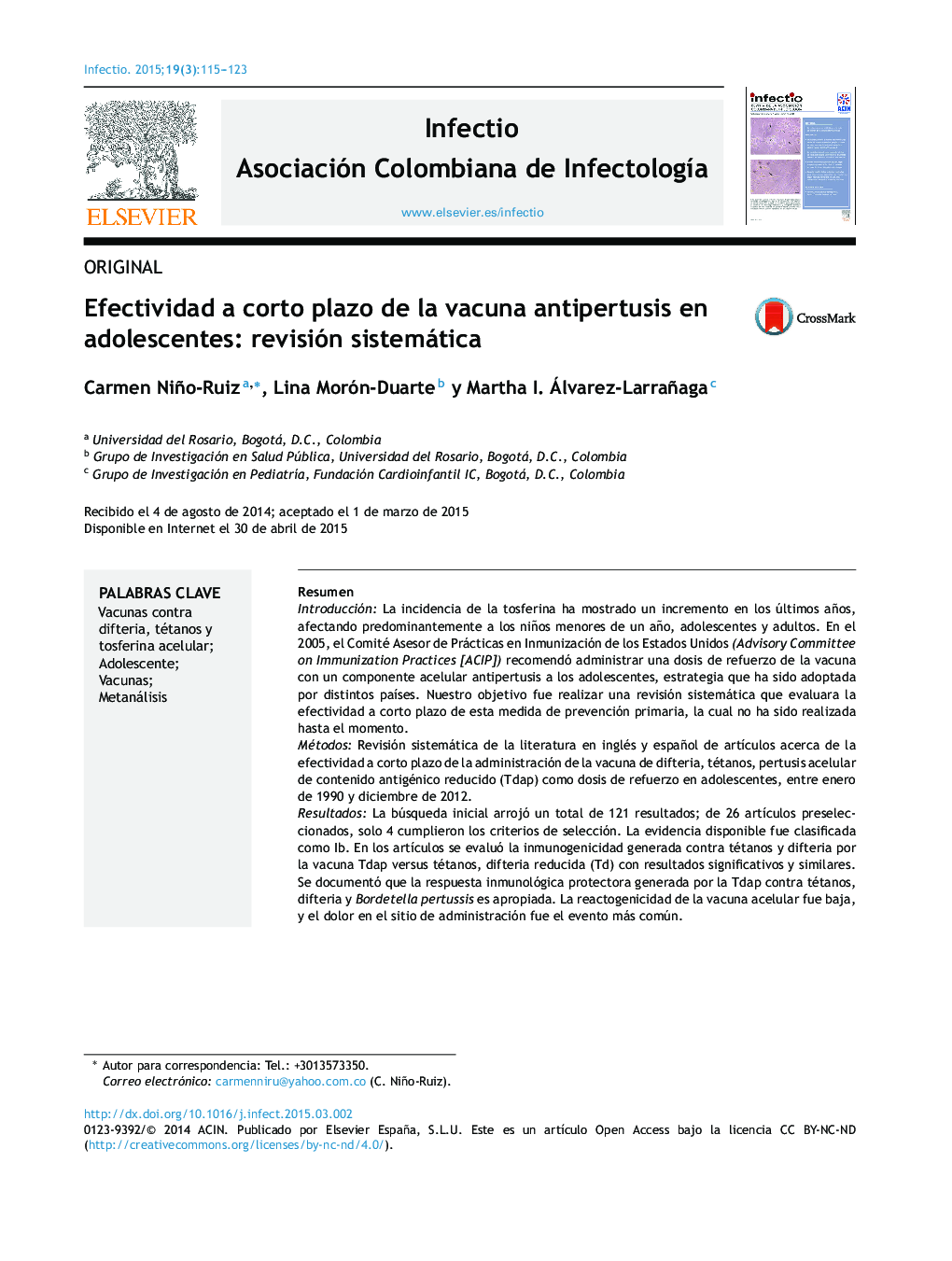| Article ID | Journal | Published Year | Pages | File Type |
|---|---|---|---|---|
| 3403733 | Infectio | 2015 | 9 Pages |
ResumenIntroducciónLa incidencia de la tosferina ha mostrado un incremento en los últimos años, afectando predominantemente a los niños menores de un año, adolescentes y adultos. En el 2005, el Comité Asesor de Prácticas en Inmunización de los Estados Unidos (Advisory Committee on Immunization Practices [ACIP]) recomendó administrar una dosis de refuerzo de la vacuna con un componente acelular antipertusis a los adolescentes, estrategia que ha sido adoptada por distintos países. Nuestro objetivo fue realizar una revisión sistemática que evaluara la efectividad a corto plazo de esta medida de prevención primaria, la cual no ha sido realizada hasta el momento.MétodosRevisión sistemática de la literatura en inglés y español de artículos acerca de la efectividad a corto plazo de la administración de la vacuna de difteria, tétanos, pertusis acelular de contenido antigénico reducido (Tdap) como dosis de refuerzo en adolescentes, entre enero de 1990 y diciembre de 2012.ResultadosLa búsqueda inicial arrojó un total de 121 resultados; de 26 artículos preseleccionados, solo 4 cumplieron los criterios de selección. La evidencia disponible fue clasificada como Ib. En los artículos se evaluó la inmunogenicidad generada contra tétanos y difteria por la vacuna Tdap versus tétanos, difteria reducida (Td) con resultados significativos y similares. Se documentó que la respuesta inmunológica protectora generada por la Tdap contra tétanos, difteria y Bordetella pertussis es apropiada. La reactogenicidad de la vacuna acelular fue baja, y el dolor en el sitio de administración fue el evento más común.ConclusiónLa evidencia disponible indica que se puede recomendar la vacuna Tdap como dosis de refuerzo en adolescentes entre los 10 y los 18 años de edad por su baja reactogenicidad y adecuada inmunogenicidad contra tétanos, difteria y Bordetella pertussis.
IntroductionIn recent years, there has been an increase in the number of cases of pertussis, predominantly affecting infants under one year of age, teenagers and adults. In 2005, the Advisory Committee on Immunization Practices of the United States (ACIP) recommended administering a booster shot of acellular pertussis-containing vaccine for teenagers, a strategy adopted by various countries. Our objective was to perform a systematic review of the short-term effectiveness of this preventive strategy. As far as we know, this review has not been performed to date.MethodsA systematic literature review of publications in English and Spanish on the short-term effectiveness of a reduced antigen content diphteria-tetanus-acellular pertussis vaccine (Tdap) as a booster shot for teenagers, between January 1990 and December 2012.ResultsAn initial search revealed a total of 121 results; of 26 papers preselected, 4 were included in the review. They were classified as level of evidence Ib. The immunogenicity against tetanus and diphtheria was tested with the Tdap vaccine versus tetanus, reduced diphtheria (Td). The authors found that the immune responses were significant and similar. The responses to the Tdap against specific antigens of Bordetella pertussis, diphtheria and tetanus were appropriate and significant. The reactogenicity was low, and the most common local adverse event was pain, predominantly in the group that received Tdap.ConclusionsAvailable evidence supports the strategy of using Tdap vaccine as a booster in teenagers from 10 to 18 years of age. This conclusion is based on its low reactogenicity and its adequate immunogenicity against tetanus, diphtheria and Bordetella pertussis.
